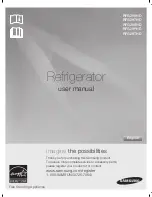
Do not place any appliance which
gives off heat, such as a toaster or
microwave oven on top of this appli-
ance, as this would increase the ap-
pliance’s energy consumption.
Location
The appliance should be installed in a
dry, well ventilated room.
The room temperature should not go
above or below the climate range for
which the appliance is designed. The
higher the ambient temperature of the
room the more energy the appliance re-
quires to operate. It should not be in-
stalled where it is exposed to direct
sunlight or directly adjacent to a
heat-producing appliance such as an
oven or a radiator.
Climate range
The appliance is designed for a partic-
ular climate range (ambient room tem-
perature), and should not be used out-
side this range. The climate range of
this appliance is stated on the data
plate inside the appliance.
Climate range
Ambient room tempera-
ture
SN
N
ST
T
+10 °C to +32 °C
+16 °C to +32 °C
+18 °C to +38 °C
+18 °C to +43 °C
Operating in a room which is too cold
will cause the cooling system to switch
off for too long causing the internal tem-
perature in the appliance to rise with
the risk of food deteriorating and going
off.
Ventilation
Air at the rear of the appliance gets
warm. To ensure sufficient ventilation
the ventilation gaps must not be cov-
ered over.
The air inlet and outlet must not be cov-
ered or blocked in any way. They
should be dusted on a regular basis.
Handle transit position
When you open the door for the first
time, the handles will make a clicking
sound. This is quite normal and indi-
cates that they have adjusted them-
selves from their transit position to their
operational position. The handles will
now protrude slightly more in front of
the appliance than they did during
transportation.
Installation
^
Remove any cable clips from the rear
of the appliance.
^
Check that all parts at the rear of the
appliance are unhindered. Remove
any hindrance.
^
Carefully push the appliance into po-
sition.
Installation
34







































